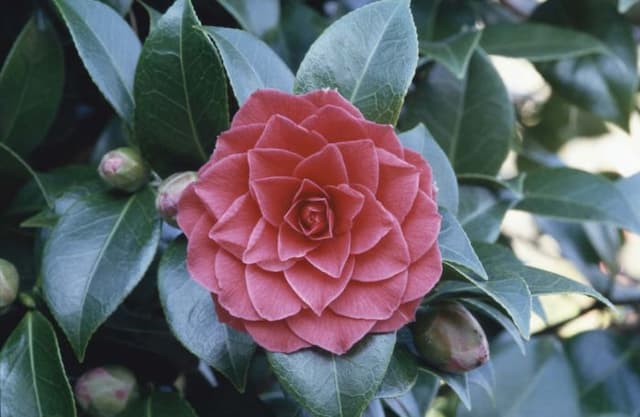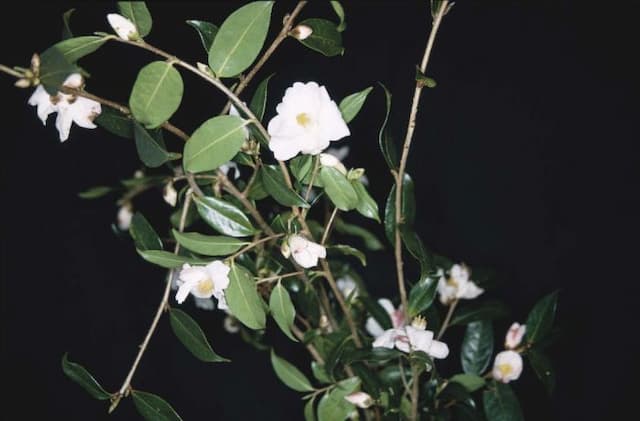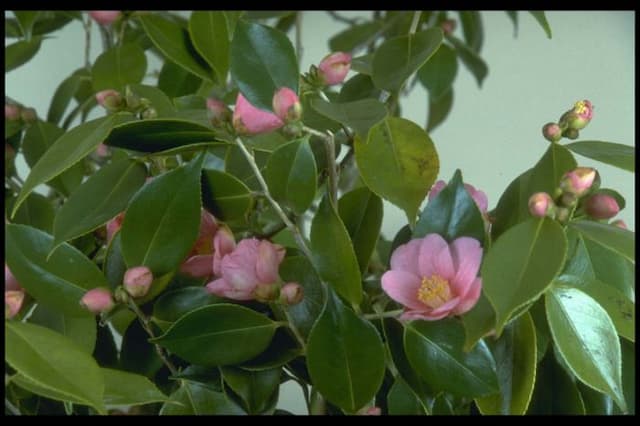Japanese Camellia Camellia japonica 'Primavera'

ABOUT
Camellia japonica 'Primavera' is an ornamental shrub known for its beautiful blooms and lustrous foliage. Its central feature is the large, showy flowers that come in a range of shades from white to pink and deep red, often with multiple tones enhancing the petals' aesthetic. The flowers have a classic, layered appearance, resembling a formal rose, with a profusion of overlapping petals that sometimes display a ruffled look. These blossoms can create a striking contrast against the plant's glossy, dark green leaves, which are typically oval-shaped and have a leathery texture. This evergreen has a dense, rounded form giving it a lush, full-bodied appearance. Adding to its allure, the blooms often possess a mild, sweet fragrance, making it not only a visual asset but a treat for the senses.
About this plant
 Names
NamesFamily
Theaceae
Synonyms
Japanese Camellia, Common Camellia, Rose of Winter
Common names
Camellia japonica 'Primavera'.
 Toxicity
ToxicityTo humans
Japanese camellia, commonly known as Japanese camellia, is not considered toxic to humans. Ingesting any part of this plant is not typically associated with poisoning or toxic symptoms. However, as with any plant material, individual allergies or reactions are possible, and ingesting plant parts is generally not advised.
To pets
Japanese camellia is also not considered toxic to pets. It does not typically cause poisoning or toxic symptoms if ingested by animals such as cats and dogs. Nevertheless, consumption of plant material can sometimes lead to gastrointestinal upset in pets, such as vomiting or diarrhea, due to the ingestion of non-food items rather than toxicity. Owners should still discourage pets from eating any part of this plant.
 Characteristics
CharacteristicsLife cycle
Perennials
Foliage type
Evergreen
Color of leaves
Varies
Flower color
Pink
Height
6-10 feet (1.8-3 meters)
Spread
5-7 feet (1.5-2.1 meters)
Plant type
Shrub
Hardiness zones
7
Native area
Japan
Benefits
 General Benefits
General Benefits- Ornamental Value: Camellia japonica 'Primavera' is popular for its beautiful, showy flowers that enhance garden aesthetics, particularly during late winter to spring when few other plants are in bloom.
- Longevity: Camellias are known to be long-lived plants, capable of thriving for decades with proper care, adding permanence and maturity to landscapes.
- Shade Tolerance: This plant is well-suited for shaded or partially shaded areas, making it a great choice for adding color to understory plantings or north-facing gardens.
- Evergreen Foliage: As an evergreen, the Camellia japonica 'Primavera' provides year-round foliage, maintaining garden interest even when not in flower.
- Versatility: It can be used in a variety of landscape applications such as specimen planting, hedges, or container gardening, offering flexibility in garden design.
- Attracts Pollinators: The flowers can attract bees and other pollinators, supporting local ecosystems and benefiting other plants in the garden.
- Drought Resistance: Once established, Camellias can be relatively drought tolerant, requiring less frequent watering compared to other garden plants.
- Moderate Growth Rate: Its moderate growth rate makes it easier to maintain and less likely to outgrow its space quickly.
- Low Maintenance: Camellia japonica 'Primavera' generally requires minimal pruning and care, which is ideal for gardeners seeking lower maintenance plants.
 Medical Properties
Medical PropertiesThis plant is not used for medical purposes.
 Air-purifying Qualities
Air-purifying QualitiesThis plant is not specifically known for air purifying qualities.
 Other Uses
Other Uses- Ornamental hair accessory: Camellia blooms can be used as natural and elegant hair decorations, especially in traditional Japanese hairstyles.
- Bonsai cultivation: Camellia japonica 'Primavera' can be grown as a bonsai, meticulously pruned and styled to create miniature landscapes.
- Dye production: The petals of the Camellia can sometimes be used to produce natural dyes for fabrics or crafts.
- Culinary garnish: The flowers, when free of pesticides, can be used as a beautiful and delicate garnish for special dishes.
- Greeting cards or bookmarks: Dried Camellia petals can be pressed and used in creating unique and personalized greeting cards or bookmarks.
- Photography prop: Camellia flowers are popular as a photography prop to add a touch of natural beauty to product or portrait photography.
- Floral water: Distilling Camellia flowers can create a lightly scented floral water that can be used for refreshing the face or room.
- Wedding decorations: Camellia flowers provide an elegant option for wedding floral arrangements, bouquets, and venue decorations.
- Art inspiration: Camellia japonica's vibrant hues and form serve as an exquisite subject for paintings, illustrations, and other visual art forms.
- Tea ceremonies: While not used in the tea itself, Camellia flowers can play a decorative role in traditional tea ceremonies, adding to the aesthetic and harmony of the setting.
Interesting Facts
 Feng Shui
Feng ShuiThe Camellia is not used in Feng Shui practice.
 Zodiac Sign Compitability
Zodiac Sign CompitabilityThe Camellia is not used in astrology practice.
 Plant Symbolism
Plant Symbolism- Admiration: The Camellia japonica, commonly known as the Japanese camellia, often signifies deep admiration and is given as a gift to someone who is respected and looked up to.
- Perfection or Excellence: With its flawless beauty, the camellia represents the ideal of perfection or excellence, a compliment to someone's impeccable qualities or achievements.
- Love: The luxurious and delicate nature of the camellia's bloom is symbolic of love and is often associated with romantic desire, passion, and the longing of the heart.
- Affection: The flower is also a token of genuine affection towards someone, embodying the warmth and fondness of a friend or family member.
- Long-lasting Devotion: The resilience and long blooming season of the camellia represent enduring devotion and loyalty, suggesting a love or commitment that stands the test of time.
- Beauty: Camellias are widely admired for their beauty, and thus they symbolize the inner and outer beauty of a person.
 Water
WaterJapanese Camellia, or Camellia japonica 'Primavera', prefers moist, well-drained soil and should be watered to maintain consistent moisture. Generally, you should water the plant once a week, providing about 1-1.5 gallons per session, depending on the size of the plant and the weather conditions. During the growing season in spring and summer, the soil should be kept slightly more moist and may require more frequent watering, especially in hotter, drier climates. Cut back on watering during the fall and winter when the plant is not actively growing, but do not allow the soil to completely dry out. Always water the plant at the base and avoid wetting the foliage to reduce the risk of disease.
 Light
LightThe Japanese Camellia thrives in partial shade to light, filtered sun. The ideal location would be a spot that receives morning light but is protected from the intense heat of the afternoon sun. In regions with cooler climates, a camellia can tolerate more sun, but in hot areas, they will need protection from the strong midday rays. Always situate your camellia in a place where the light is dappled, such as under a canopy of deciduous trees or on a north-facing site with bright, indirect light.
 Temperature
TemperatureJapanese Camellias are suited for a temperate climate and perform best in temperatures ranging from 50 to 80 degrees Fahrenheit. They can handle a brief dip in temperature to around 20 degrees Fahrenheit but should be protected from prolonged exposure to freezing conditions. The ideal temperature for robust growth and flowering for the Japanese Camellia is between 60 and 70 degrees Fahrenheit.
 Pruning
PruningPruning a Japanese Camellia is important for maintaining its shape, removing any dead or damaged branches, and encouraging new growth and flowering. The best time to prune is right after the camellia has finished flowering in the spring, as pruning later in the season can remove next season's buds. Thin out dense branches to allow light into the center of the plant and improve air circulation. You should prune as often as needed to maintain the desired shape and size of the plant.
 Cleaning
CleaningAs needed
 Soil
SoilJapanese Camellia 'Primavera' prospers in acidic soil with a pH between 5.5-6.5. A good mix would be 50% peat moss or acid compost, 30% garden soil, and 20% perlite or sand for drainage.
 Repotting
RepottingJapanese Camellia 'Primavera' should be repotted every two to three years or when rootbound. Repotting is best done in late winter or early spring before the growing season starts.
 Humidity & Misting
Humidity & MistingJapanese Camellia 'Primavera' thrives in moderate to high humidity levels. The ideal range is between 40%-60% for optimal growth and bloom production.
 Suitable locations
Suitable locationsIndoor
Place Japanese Camellia 'Primavera' near bright, filtered light and maintain high humidity.
Outdoor
Plant in partial shade, shelter from strong winds, and keep soil moist.
Hardiness zone
7-9 USDA
 Life cycle
Life cycleThe Camellia japonica 'Primavera', commonly known as Japanese camellia, begins its life cycle as a seed, typically germinating in a moist, well-drained soil environment with partial shade. After germination, it enters a seedling stage, where the plant develops its first true leaves and a root system capable of sustaining growth. As the seedling matures into a young plant, it undergoes vegetative growth, forming a bushy evergreen structure with glossy, dark green leaves. Upon reaching maturity, the Japanese camellia produces vibrant flowers, usually during late winter to early spring, signaling its reproductive stage, where it relies on pollinators like bees for cross-pollination or can self-pollinate. After fertilization, the plant produces fruit in the form of dry capsules containing seeds, which upon maturity, are dispersed to give rise to new plants. The camellia can live for many years, with some specimens reaching over 100 years of age, entering a period of senescence before eventually dying.
 Propogation
PropogationPropogation time
Spring-Early Summer
Camellia japonica 'Primavera', commonly known as the Japanese camellia, is most effectively propagated through semi-hardwood cuttings. This method tends to be the most popular due to its relative simplicity and effectiveness. The best time to take cuttings for propagation is during the midsummer to early fall when the new growth has matured enough to become semi-hardwood, which typically means it's not too soft and has a bit of flexibility. For propagation, a cutting of approximately 4 to 6 inches (10-15 cm) should be taken just below a set of leaves, and then the lower leaves should be removed. The cutting is usually treated with a rooting hormone to encourage root development and then inserted into a well-draining potting mix. It's essential to maintain high humidity around the cutting, often achieved by covering it with a plastic bag or a propagation dome, and to keep it in warm conditions, away from direct sunlight, until roots have developed.









